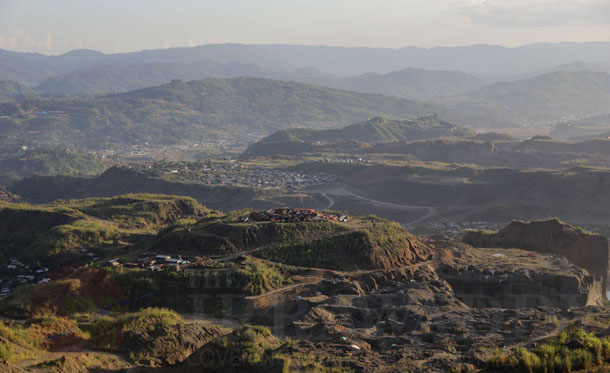Heavy rain over the past few days has inundated parts of Kachin State, including in the jade-rich region of Hpakant, as well as Mogaung and Mohnyin townships, with water levels rising several feet high and flooding homes since Saturday evening.
Affected communities were still grappling with the impact of flooding which began in early July and has affected swathes of the country.
Bauk Ja, Kachin State minister for Social Welfare, told The Irrawaddy that downtown communities in Hpakant were badly affected but any casualties were not yet known. Flooded communities were being supported by the state government and members of the Myanmar Red Cross, she said.
“When heavy rain comes, huge piles of waste block the nearby Uyu tributary [off the Chindwin River] which causes inundation,” Bauk Ja said. “But the water level went down a little on Tuesday.”
Than Zaw Oo, a second-lieutenant in the Hpakant police force, said relief camps for those displaced from four communities in Hpakant Township had been set up in the Myoma quarter, including in a monastery.
Last year, more than three dozen homes were damaged due to flooding in Hpakant, a jade mining hub in the northern state. Landslides in the area—some due to mining and others blamed on heavy rains—have killed scores of people over the last several years.
Prominent Burmese meteorologist Dr Tun Lwin warned in a Facebook post on Tuesday of further possible floods and landslides in Kachin State and Sagaing Division due to continuous heavy rainfall over recent days.
Government weather forecasts have also predicted continuous rainfall in northern Burma in the days to come.
Bauk Ja, an activist and member of the National Democratic Force who is currently facing trial for helping farmers protest land confiscation, told The Irrawaddy that the road from Mogaung to Hpakant had been rendered unusable following heavy rains.
“I had to turn back on the road to Hpakant from Mogaung on Saturday as bridges on the way were damaged and the road partly destroyed,” she said.
In Mogaung, a child had died due to the flooding, said Bauk Ja, the Kachin State minister who has the same name as the aforementioned activist.
Over 3,000 acres of farmland near the biggest local reservoir, Indawgyi Lake, has been destroyed in recent weeks, she said, and the local government was assisting affected farmers.
Mar Khar, a resident of Myitkyina, said the Irrawaddy River’s water levels had continued rising in the past week and he feared flooding in the Kachin State capital if rains continued.
Severe flooding occurs in the town around every seven to 10 years, Mar Khar said, adding that as the last serious flood was over a decade ago, residents are wary of a similar inundation in 2015.
The state-level minister Bauk Ja said authorities were carefully monitoring the water level of the Irrawaddy River but that it had “not yet reached the high water mark.”
In Chin State, one of the states hardest hit by recent flooding, at least 20 people from Tuikhing Zang (Hakha Lay) village in Tonzang Township remain unaccounted for after a mudslide in the area on Friday, according to Chin State forestry minister Kyaw Nyein.
Around 180 houses in the village were destroyed by the mudslide, the minister said.
As of late August, the government estimated that over 1.6 million people were affected by floods and landslides across Burma since July, with over 384,000 households displaced and 1.4 million acres of farmland inundated.
Nang Seng Nom & Salai Thant Zin contributed reporting.

















